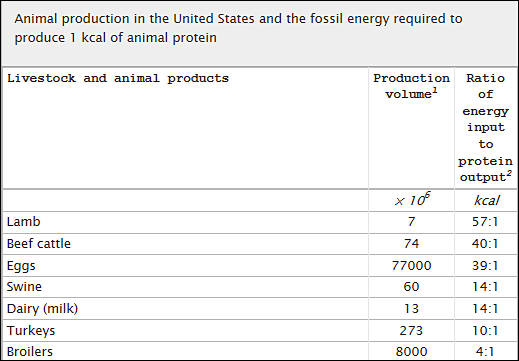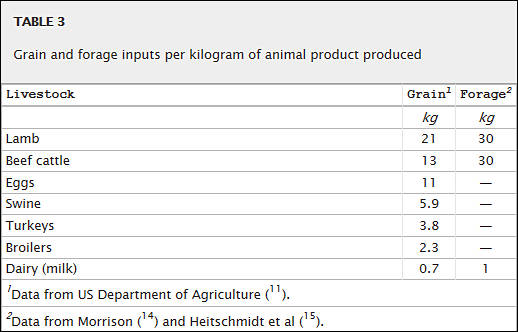
It allows to keep PV going, with more focus towards AI, but keeping be one of the few truly independent places.
-
Fossil energy is expended in livestock production systems. For example, broiler chicken production is the most efficient, with an input of 4 kcal of fossil energy for each 1 kcal of broiler protein produced. The broiler system is primarily dependent on grain. Turkey, also a grain-fed system, is next in efficiency, with a ratio of 10:1. Milk production, based on a mixture of two-thirds grain and one-third forage, is relatively efficient, with a ratio of 14:1. Both pork and egg production also depend on grain. Pork production has a ratio of 14:1, whereas egg production has a 39:1 ratio.

livestock systems depending most heavily on forage but also using significant amounts of grain are the beef and lamb production systems. The beef system has a ratio of 40:1, while the lamb has the highest, with a ratio of 57:1. If these animals were fed on only good-quality pasture, the energy inputs could be reduced by about half.

Average fossil energy input for all the animal protein production systems studied is 25 kcal fossil energy input per 1 kcal of protein produced. This energy input is more than 11 times greater than that for grain protein production, which is about 2.2 kcal of fossil energy input per 1 kcal of plant protein produced.

 img899.jpg519 x 361 - 36K
img899.jpg519 x 361 - 36K
 img900.jpg518 x 332 - 37K
img900.jpg518 x 332 - 37K -
What's the kcal of a carrot?
-
What you mean by question? Fossil energy expense?
Howdy, Stranger!
It looks like you're new here. If you want to get involved, click one of these buttons!
Categories
- Topics List23,992
- Blog5,725
- General and News1,355
- Hacks and Patches1,153
- ↳ Top Settings33
- ↳ Beginners256
- ↳ Archives402
- ↳ Hacks News and Development56
- Cameras2,367
- ↳ Panasonic995
- ↳ Canon118
- ↳ Sony156
- ↳ Nikon96
- ↳ Pentax and Samsung70
- ↳ Olympus and Fujifilm101
- ↳ Compacts and Camcorders300
- ↳ Smartphones for video97
- ↳ Pro Video Cameras191
- ↳ BlackMagic and other raw cameras116
- Skill1,960
- ↳ Business and distribution66
- ↳ Preparation, scripts and legal38
- ↳ Art149
- ↳ Import, Convert, Exporting291
- ↳ Editors191
- ↳ Effects and stunts115
- ↳ Color grading197
- ↳ Sound and Music280
- ↳ Lighting96
- ↳ Software and storage tips266
- Gear5,420
- ↳ Filters, Adapters, Matte boxes344
- ↳ Lenses1,582
- ↳ Follow focus and gears93
- ↳ Sound499
- ↳ Lighting gear314
- ↳ Camera movement230
- ↳ Gimbals and copters302
- ↳ Rigs and related stuff273
- ↳ Power solutions83
- ↳ Monitors and viewfinders340
- ↳ Tripods and fluid heads139
- ↳ Storage286
- ↳ Computers and studio gear560
- ↳ VR and 3D248
- Showcase1,859
- Marketplace2,834
- Offtopic1,319





